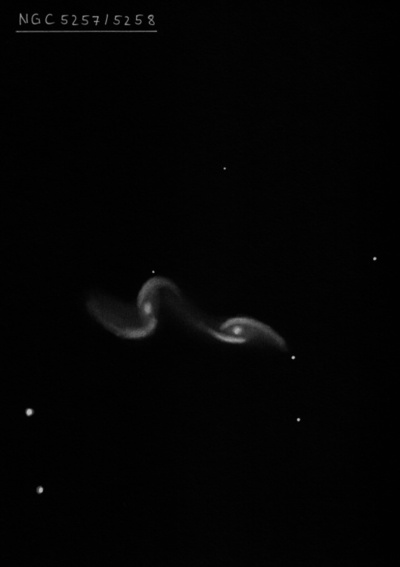
William Herschel discovered NGC 5257 = H II-895 = h1654, along with NGC 5258, on 13 May 1793 (sweep 1044) and noted "F, S, iR." JH made the single observation "The first of 2 comprising a double nebula; both vF; R; bM. The smaller of the two."
400/500mm - 17.5" (4/28/90): fairly faint, fairly small, oval 3:2 WSW-ENE, weak concentration. A mag 14 star is off the west side 1.7' from the center. Forms a close, interacting pair (Arp 240) with NGC 5258 1.3' SE.
900/1200mm - 48" (5/4/16): at 610x; very bright, fairly large, striking two armed-spiral. The central portion only extends ~35", but contains a fascinating structure. Along the southwest and northeast flanks are sharp-edged prominent "arms", appearing as thin, high surface brightness arcs, with the southern arc slightly brighter. Both "arms" are slightly convex, appearing like a close pair of parenthesis enclosing the central region! The northern arm continues as a fainter, but easily visible, fairly thin arc extending west-northwest, and ends just before reaching a mag 15 star [1.7' WNW of center]. A thin, very low surface brightness arm extends west from the southern "parenthesis" towards NGC 5258 (1.4' ESE), but stops just short. The tip-to-tip distance between the two arms is ~1.6'.
On the inside of the two bright "arcs" (blue star-forming arms) there appear to be two thin dust lanes as the surface brightness drops dramatically. At the center is a fairly faint stellar nucleus. The overall appearance is very unusual as the surface brightness of the core region is lower than the thin pair of symmetrical arms.
Notes by Steve Gottlieb